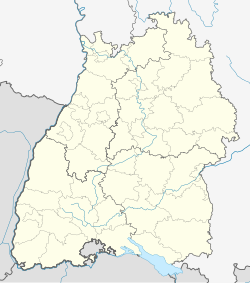Schwäbisch Hall is a Landkreis (district) in the northeast of Baden-Württemberg, Germany. Neighboring districts are Main-Tauber, the Bavarian district Ansbach, Ostalbkreis, Rems-Murr, and Hohenlohe.

Fellbach is a mid-sized town on the north-east edge of Stuttgart in Baden-Württemberg, Germany. With a population of approximately 45.430 as of December 2020 is the second largest town in the District Rems-Murr-Kreis. The area of the town is 27.7 km2 (10.7 sq mi).

Adelmannsfelden is a municipality in the German state of Baden-Württemberg, in Ostalbkreis district.
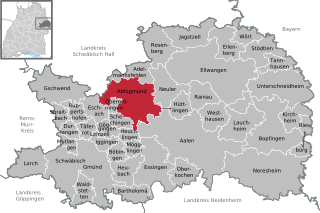
Abtsgmünd is a municipality in the German state of Baden-Württemberg, in Ostalbkreis district. Abtsgmünd is located at the confluence of two streams, the Lein and the Kocher. The large area municipality consists of the main town of Abtsgmünd as well as the five districts of Neubronn, Laubach, Untergröningen, Hohenstadt and Pommertsweiler and their associated villages and hamlets. The municipality is a state-recognized recreation area in the Swabian-Franconian Forest Nature Park.

Eschach is a municipality in the German state of Baden-Württemberg, in Ostalbkreis district.
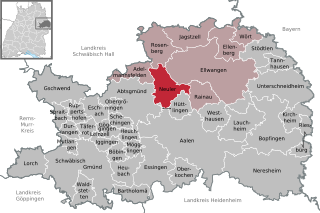
Neuler is a town in the German state of Baden-Württemberg, in Ostalbkreis district.
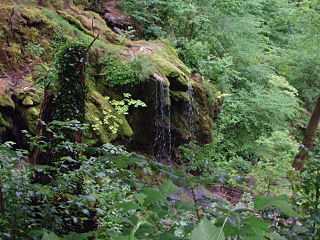
Neidlingen is a municipality in the district of Esslingen, in Baden-Württemberg, Germany.

Albershausen is a municipality in the district of Göppingen in Baden-Württemberg in southern Germany.

Böhmenkirch is a municipality in the district of Göppingen in Baden-Württemberg, Germany.

Eschenbach is a municipality in the district of Göppingen in Baden-Württemberg in Germany.

Hattenhofen is a municipality in the district of Göppingen in Baden-Württemberg in southern Germany.

Ottenbach is a municipality in the district of Göppingen in Baden-Württemberg in southern Germany.

Zell unter Aichelberg is a municipality in the district of Göppingen in Baden-Württemberg in southern Germany.

Plüderhausen is a municipality east of Schorndorf in the Rems-Murr district in Baden-Württemberg, Germany. It belongs to the Stuttgart Metropolitan Region.

Frankenhardt is a rural Gemeinde (municipality) in the district of Schwäbisch Hall in Baden-Württemberg in Germany. It consists of thirty-nine villages, hamlets and other settlements. The largest village is Honhardt, followed by Gründelhardt and Oberspeltach. The township lies about twenty kilometres east of the town of Schwäbisch Hall.

Hüttlingen is a municipality in the German state of Baden-Württemberg, in Ostalbkreis district.
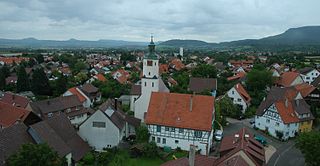
Dürnau is a municipality in the district of Göppingen in Baden-Württemberg in southern Germany.

Bisingen is a municipality in the Zollernalbkreis district of Baden-Württemberg, Germany.

Beutelsbach is a town district or Stadtteil within the town of Weinstadt in Rems-Murr district, Baden-Württemberg, Germany. The Stadtteil has a population of 8,464 and an elevation of 236 m above sea level.

The Frickenhofer Höhe is hill range, up to 565.4 m above sea level (NHN), in the German state of Baden-Württemberg. Most of the range falls within the county of im Ostalbkreis but its northern spurs reach into Schwäbisch Hall. The elongated plateau-like region is named after the village of Frickenhofen, a settlement on the narrow northwest tip of the hills in the municipality of Gschwend.



